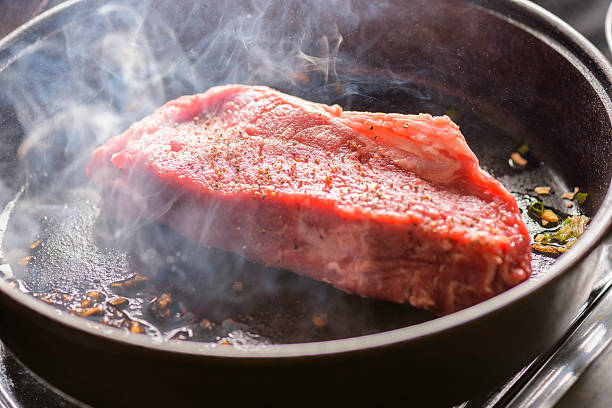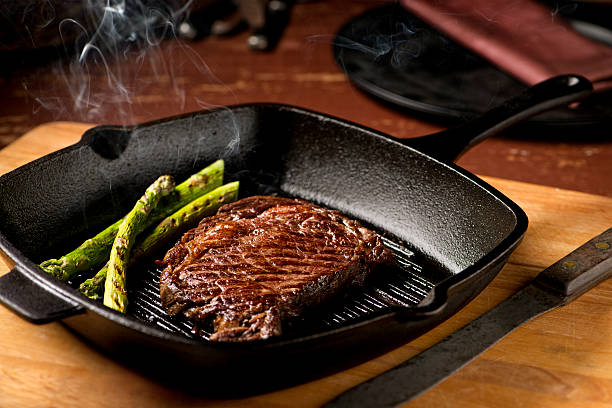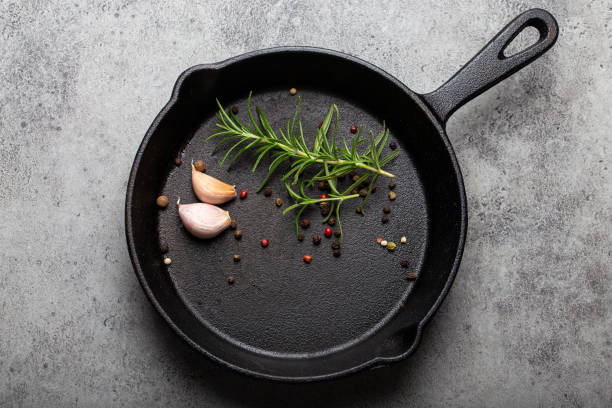In the culinary world, the sizzle and aroma of a perfectly seared dish evoke a sensory symphony that captivates both chefs and diners alike. Yet, the enigmatic dance of smoke emerging from a cast iron pan often leaves kitchen enthusiasts puzzled.
It’s a spectacle that transcends the ordinary cooking experience, prompting us to ponder: Why do these robust pans, revered for their durability and versatility, occasionally cloak themselves in a veil of smoke?
Behind this culinary spectacle lies a fascinating chemistry, a delicate interplay of heat, seasoning, and the very essence of what makes cast iron an icon in the kitchen. Let’s delve into the smoky secrets of cast iron pans and unravel the flavorful mystery that wafts through the kitchen air.

Why Do Cast Iron Pans Smoke
Cast iron pans smoke due to the polymerization of oils, causing the formation of a non-stick layer.
This process is essential for seasoning, enhancing flavor, and preventing rust. Understanding the science behind the smoke reveals the secret to achieving the perfect sear and maintaining a well-seasoned cast iron pan.
The Sizzling Chemistry: Polymerization and Smoke
Cast iron pans smoke as a result of polymerization, a chemical reaction where the oil on the pan’s surface transforms into a solid, non-stick layer.
This process occurs when the pan is heated, causing the oil molecules to bond and create a durable coating. The smoke produced is a byproduct of this reaction and is an integral part of building the pan’s seasoning.
Seasoning Magic: Flavor Enhancement and Rust Prevention
The smoking phase is crucial for seasoning cast iron pans, contributing to enhanced flavor in subsequent cooking. The polymerized layer not only imparts a unique taste but also acts as a protective barrier, preventing rust and ensuring the pan’s longevity.
Regular seasoning maintains the pan’s quality and imparts a distinctive character to each dish.
Tips to Control Smoking: Temperature and Oil Choices
Controlling the smoking process is an art. Adjusting the temperature and choosing the right oil are key factors. Using oils with high smoke points, such as vegetable or grapeseed oil, minimizes smoke.
Additionally, preheating the pan gradually allows the polymerization process to occur more efficiently, reducing excessive smoking and ensuring a well-seasoned cast iron surface.
Achieving the Perfect Sear: Mastering the Smoke
The smoke from a cast iron pan signifies the transformation of oil into a protective, flavorful layer. Embrace the sizzling chemistry, as it is the key to achieving the perfect sear and unlocking the full potential of your cast iron cookware.
Understanding why cast iron pans smoke empowers you to master the art of seasoning, elevating your culinary creations to new heights.
Cast-iron pans can produce smoke during cooking due to several factors. Understanding these elements can help you manage and prevent excessive smoking while using these durable cookware pieces.
What Makes Cast-Iron Pans Smoke?
1. Seasoning Process
When cast-iron pans are seasoned with oil or fat to create a protective layer, the residue left after the seasoning process can contribute to smoking. This is a normal part of the initial seasoning, but it decreases over time as the pan builds up a more robust, non-stick coating.
2. Excessive Heat
Subjecting a cast-iron pan to excessively high temperatures can lead to smoking. High heat causes any residual oils or fats on the pan’s surface to reach their smoke point. To prevent this, it’s crucial to use moderate heat settings, especially when preheating the pan.
3. Residual Food Particles
Leftover food particles can also be a culprit. If the pan is not properly cleaned after each use, these remnants can burn and generate smoke during subsequent cooking sessions. Thoroughly cleaning the pan with a brush or scraper can help minimize this issue.
4. Type of Cooking Oil
The type of oil used for cooking plays a role. Oils with low smoke points, such as olive oil, can contribute to smoking. Opting for oils with higher smoke points, like vegetable or canola oil, can reduce the likelihood of smoke during cooking.
5. Lack of Ventilation
Poor ventilation in the kitchen can exacerbate smoking issues. Proper ventilation helps dissipate smoke, preventing it from accumulating in the cooking area. Using exhaust fans or opening windows can be effective in minimizing smoke buildup.
6. Water Interaction
If water comes into contact with a hot cast-iron pan, it can create steam and contribute to smoking. This is particularly relevant when cooking moist or watery ingredients. Dry the pan thoroughly before heating to avoid this situation.
7. Inadequate Preheating
Inadequate preheating of the cast-iron pan can lead to uneven cooking and smoking. Ensure the pan is sufficiently preheated before adding ingredients. This not only prevents smoking but also enhances the pan’s cooking performance.

Cast Iron Materials
Cast iron is a versatile and durable material widely used in various applications, known for its excellent heat retention, even heating, and longevity. Here’s a closer look at the materials that make up cast iron:
1. Iron
The primary component of cast iron is iron itself. Iron ore is melted in a furnace to extract molten iron, which is then combined with other elements to create the alloy. The iron used in cast iron provides the strength and structural integrity that make these pans robust and long-lasting.
2. Carbon
Carbon is a crucial element in cast iron, contributing to its hardness and brittleness. The carbon content in cast iron typically ranges from 2% to 4%, making it higher than in steel. The presence of carbon gives cast iron its distinctive properties, such as being prone to brittleness but offering excellent heat retention.
3. Silicon
Silicon is commonly present in cast iron, typically in the range of 1% to 3%. Silicon helps improve the fluidity of the molten iron during the casting process, making it easier to pour into molds and ensuring that the final product has a smooth and uniform structure.
4. Manganese
Manganese is another alloying element found in cast iron, usually in smaller amounts. It enhances the strength and toughness of the material. Manganese also helps counteract the negative effects of sulfur impurities that may be present in the iron.
5. Sulphur and Phosphorus
Sulfur and phosphorus are considered impurities in cast iron and are usually kept at low levels. High levels of these elements can lead to casting difficulties and reduce the material’s overall strength and durability.
6. Traces of Other Elements
Depending on the specific type of cast iron, trace amounts of other elements like nickel, copper, and chromium may be present. These elements can influence the cast iron’s properties, such as corrosion resistance and machinability.
7. Foundry Additives
During the casting process, various additives, such as fluxes and inoculants, may be used to control the quality of the cast iron. Fluxes help remove impurities, and inoculants can modify the microstructure, improving the final product’s properties.
How to Prevent Cast-Iron Pans From Smoking
1. Cleaning and Seasoning
Proper cleaning and seasoning are essential to prevent cast-iron pans from smoking. After each use, clean the pan thoroughly with a brush or scraper to remove any residual food particles. Avoid using soap, as it can strip away the pan’s seasoning.
To maintain and enhance the non-stick coating, regularly season the cast iron by applying a thin layer of oil and baking it in the oven. This protective layer not only prevents sticking but also reduces the likelihood of smoking during cooking.
2. Avoid High Temperatures
Exposing cast-iron pans to excessively high temperatures can lead to smoking. To prevent this, use moderate heat settings when cooking. Preheat the pan gradually rather than rapidly, allowing it to evenly distribute heat.
This not only minimizes smoking but also ensures that the seasoning on the pan remains intact. Controlling the cooking temperature is crucial for a smoke-free cooking experience with cast iron.
3. Ingredients
The ingredients you use can impact the smoking behavior of cast-iron pans. Foods with high water content or that release moisture during cooking can contribute to smoking. Pat dry ingredients before adding them to the pan to reduce the likelihood of steam and smoke.
Additionally, be mindful of marinades and sauces with high sugar content, as they can burn and generate smoke. Choosing dry or well-prepared ingredients helps maintain a smoke-free cooking environment.
4. Oil’s Matter
The type of cooking oil you use plays a significant role in preventing smoking. Opt for oils with high smoke points, such as vegetable oil, canola oil, or grapeseed oil. These oils can withstand higher temperatures without breaking down and producing smoke.
Avoid using oils with low smoke points, like olive oil, for high-heat cooking in cast-iron pans. Using the right oil not only prevents smoking but also contributes to the overall flavor and quality of your dishes.

What Type of Pan Can I Use if I Don’t Want Smoky Cast-Iron
If you prefer a cooking experience without the potential for smoke that can be associated with cast-iron pans, several alternative cookware options offer different features and benefits. Here are some alternatives:
1. Stainless Steel Pans
Stainless steel pans are known for their durability, resistance to rust and corrosion, and ability to maintain a polished appearance. They provide even heating and are suitable for a variety of cooking techniques. Stainless steel pans do not require seasoning and are generally non-reactive, making them a versatile choice for many recipes.
2. Nonstick Pans
Nonstick pans feature a coating that prevents food from sticking, making them convenient for low-fat cooking and easy cleanup. They are available in various materials, such as aluminum or hard-anodized aluminum. However, it’s important to use utensils that won’t scratch the nonstick surface to maintain its effectiveness.
3. Ceramic-Coated Pans
Ceramic-coated pans have a nonstick surface that is free of PTFE and PFOA. These pans offer even heat distribution and are resistant to scratching. However, they may require gentle care to avoid chipping the ceramic coating.
4. Anodized Aluminum Pans
Anodized aluminum pans have undergone a process that makes the aluminum harder and more durable. They offer even heating and are resistant to corrosion. The anodization process also makes them non-reactive, reducing the likelihood of altering the taste of acidic foods.
5. Copper Pans
Copper pans provide excellent heat conductivity, allowing for precise temperature control. They are often lined with stainless steel to prevent reactivity with certain foods. However, they require regular maintenance to retain their appearance.
6. Carbon Steel Pans
Carbon steel pans share some similarities with cast iron but are generally lighter. They require seasoning for maintenance but are known for their quick heating and even cooking. They are suitable for high-heat cooking and can develop a nonstick surface with proper care.
What Makes Cast-Iron Cooking Pots so Great?
Cast-iron cooking pots are prized for their exceptional qualities, making them a popular choice among chefs and home cooks alike. Here are some key features that contribute to the greatness of cast-iron cooking pots:
1. Excellent Heat Retention
One of the standout features of cast-iron cooking pots is their exceptional heat retention. Once heated, cast iron holds onto heat effectively and distributes it evenly across the entire surface of the pot. This property makes cast iron ideal for slow cooking, simmering, and braising, as it maintains a consistent temperature for extended periods.
2. Versatility in Cooking
Cast-iron cooking pots are incredibly versatile and can be used on various heat sources, including stovetops, ovens, and even open flames. This versatility allows for a wide range of cooking techniques, from searing and frying to baking and roasting.
The ability to transition seamlessly between different cooking methods makes cast iron a go-to choice for many culinary applications.
3. Durability and Longevity
Cast iron is renowned for its durability and longevity. When properly cared for, a cast-iron cooking pot can last for generations, making it a valuable and enduring addition to any kitchen. The sturdy construction and resistance to wear and tear contribute to the long lifespan of these pots.
4. Natural Non-Stick Surface
Over time, with proper seasoning and use, cast-iron cooking pots develop a natural non-stick surface. This non-stick quality reduces the need for excessive amounts of cooking oils or fats, making it a healthier cooking option. The well-seasoned surface also makes cleaning easier and enhances the pot’s performance over time.
5. Adds Iron to Food
Cooking with cast-iron pots can add a small amount of dietary iron to your food. This can be particularly beneficial for individuals with iron-deficiency anemia. The iron leaches into the food during cooking, especially when preparing acidic dishes, contributing to the nutritional value of the meals.
6. Enhances Flavor
Cast-iron pots are known for enhancing the flavor of dishes. The porous surface of the material absorbs and retains the flavors of spices and seasonings used in various recipes, creating rich and flavorful meals. This quality is especially prized in slow-cooked stews, soups, and sauces.
7. Easy to Maintain
While cast iron requires specific care, the maintenance is relatively simple. Regular seasoning and proper cleaning with minimal soap ensure the longevity and performance of the pot.
The more you use a cast-iron cooking pot, the better it becomes, developing a patina that enhances its non-stick properties.

FAQs
Why does my cast iron pan smoke when I use it?
Cast iron pans may smoke when they are new or haven’t been properly seasoned. This is completely normal and indicates the seasoning process is taking place, enhancing the pan’s non-stick properties.
Is it normal for my cast iron pan to produce smoke during cooking?
Yes, it’s absolutely normal. When cooking at high temperatures, some oils or fats may reach their smoke point, resulting in smoke. This doesn’t harm the pan; in fact, it adds to its character and flavor development.
How can I reduce smoking in my cast iron pan?
To minimize smoking, ensure your pan is well-seasoned, use oils with higher smoke points, and avoid overheating. Proper maintenance, including regular seasoning, contributes to a healthier cooking experience.
Why does my cast iron pan smoke even after seasoning?
If your cast iron pan continues to smoke after seasoning, it may be due to excess oil or inadequate heat polymerization. Simply wipe off any excess oil before seasoning, and ensure thorough heat exposure during the seasoning process.
Can smoking in my cast iron pan be beneficial?
Absolutely! The subtle smoke produced during cooking not only adds a unique flavor to your dishes but also indicates the creation of a natural non-stick surface, making your cast iron pan a versatile and valuable kitchen tool.
Is it necessary to season a cast iron pan to prevent smoking?
Seasoning is a crucial step in cast iron pan care. A well-seasoned pan not only minimizes smoking but also enhances its non-stick properties, making it easier to clean and maintain.
How can I prevent my cast iron pan from smoking excessively?
To prevent excessive smoking, use oils with higher smoke points, avoid cooking acidic foods in large quantities, and maintain consistent heat. These practices contribute to a smoother cooking experience with your cast iron pan.
Can I use my cast iron pan immediately after seasoning, or should I wait for it to stop smoking?
You can use your cast iron pan immediately after seasoning, even if it produces a bit of smoke initially. The smoking will gradually subside as the seasoning settles, and you’ll enjoy the benefits of a well-maintained, non-stick surface.
Does smoking affect the longevity of my cast iron pan?
No, occasional smoking does not affect the longevity of your cast iron pan. In fact, it contributes to the ongoing seasoning process, ensuring your pan remains in excellent condition for many years of delightful cooking.
Are there any health concerns associated with the smoke from a cast iron pan?
No need to worry! The smoke from a cast iron pan is generally harmless. However, it’s always a good practice to cook in a well-ventilated area. The unique flavors imparted by the slight smoking only enhance the culinary experience.
Conclusion
In conclusion, the phenomenon of cast iron pans smoking is a natural and common occurrence with a straightforward explanation rooted in the properties of the material.
As these pans heat up, the residual fats and oils left on the surface from previous cooking sessions begin to break down and reach their smoke point. This process not only contributes to the development of a non-stick seasoning but also adds a distinct flavor to the food being cooked.
While the initial smoking may cause concern for some, understanding the science behind it allows cooks to appreciate the unique qualities of cast iron cookware. With proper seasoning and care, the smoking becomes a culinary benefit, enhancing the cooking experience and creating dishes with unparalleled depth and richness.